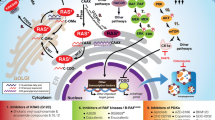Abstract
As a result of its transforming abilities, activated Ras is expressed in a great number of cancers. The ras mutation frequency varies between 95% in pancreatic cancer and 5% in breast cancer. In leukemia, the highest frequency (30%) is found in acute myeloid leukemia. The presence of ras mutations has been correlated with a poor prognosis and negative clinical outcome. This suggests that mutated Ras activates mechanisms, which favor tumor growth, enhance the metastatic capacity of tumors or modulate tumor-specific immune responses. Several new functions of Ras, such as downregulation of major histocompatibility complex molecules, upregulation of certain cytokines, growth factors and degradative enzymes have been uncovered in the last decade. Additionally, mutated Ras can also serve as a primary target for the development of immunotherapy or drug therapy. This review will discuss the mechanisms by which Ras expressing tumors are able to evade destruction by the immune system and enhance their growth and metastatic potential. It will further elaborate on the attempts to develop successful immunotherapy and drug therapy targeting Ras expressing tumors.
Similar content being viewed by others
Author information
Authors and Affiliations
Rights and permissions
About this article
Cite this article
Weijzen, S., Velders, M. & Kast, W. Modulation of the immune response and tumor growth by activated Ras. Leukemia 13, 502–513 (1999). https://doi.org/10.1038/sj.leu.2401367
Received:
Accepted:
Published:
Issue Date:
DOI: https://doi.org/10.1038/sj.leu.2401367
- Springer Nature Limited
Keywords
This article is cited by
-
The role of endothelin and RAS/ERK signaling in immunopathogenesis-related fibrosis in patients with systemic sclerosis: an updated review with therapeutic implications
Arthritis Research & Therapy (2022)
-
Prevention of Induced Colitis in Mice by the Ras Antagonist Farnesylthiosalicylic Acid
Digestive Diseases and Sciences (2012)
-
Growth hormone, the insulin-like growth factor axis, insulin and cancer risk
Nature Reviews Endocrinology (2011)
-
RAS oncogenes: weaving a tumorigenic web
Nature Reviews Cancer (2011)
-
Insulin resistance and hepatocarcinogenesis
Clinical Journal of Gastroenterology (2010)




